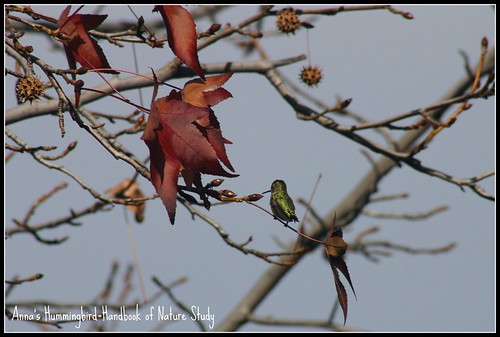 Outdoor Hour Challenge
Outdoor Hour Challenge Birds #4 Hummingbirds
(Ruby-throated, Anna’s, and Black-chinned)
Inside Preparation Work:
1. Read the Handbook of Nature Study pages 115-117 on hummingbirds. Although you may not have hummingbirds in your area, all children should have a general knowledge of the hummingbird along with its special features.
YouTube Video: Hummingbirds-BBC Nature
http://www.youtube.com/watch?v=ujN4osRD22E
2. Read and study Backyard Birds pages 20-21. These pages can be read aloud with your children and then you can ask them to narrate back something that they found interesting about the hummingbird. Be sure to discuss the illustrations and the field marks for each kind of hummingbird.

3. Peterson’s Field Guide: Read and study pages 216-221(W) or pages 186-187(E). You can also read the How Does it Fly? section in the introduction. Page 20(W) and Page 26(E). This will help you to describe better the manner in which your observed birds fly. You can ask yourself if it undulates, hovers, glides, soars, or flies straight. See the illustrations in the field guide for a better explanation.
4. Also read the Handbook of Nature Study pages 33-35 on how a bird flies. The Handbook suggests several simple experiments to help your child learn about flight. The observation questions at the end of this lesson will help your child understand a little better how the feathers, the wing, and the tail of the bird help it fly.

Outdoor Hour Time:
This week use your 10-15 minutes of outdoor time to enjoy your neighborhood birds. We find that going outdoors earlier in the day will allow us to observe more birds than during the heat of the middle of the day. Our neighborhood is also significantly quieter during the early hours and this allows us to hear more bird sounds if they are there. The hummingbird does not have a song but rather you will hear the hum of their wings as they fly near-by. Sometimes they make a clicking or squeaking sound but it is not truly a bird song like other birds.
Also, this week try to observe some birds in flight. If you can find two different birds, compare they way they use their wing shapes and their feathers to fly. Use your vocabulary to decide if the bird hovers, soars, glides, undulates or flies in a straight line.

This might be a good time to hang a feeder designed for hummingbirds. I found this website to be very helpful in learning all about hummingbird feeders.
Hummingbirds.net: Hummingbird Feeders
http://www.hummingbirds.net/feeders.html
If you would like some ideas for attracting and feeding birds in your own yard, check out my Squidoo page: What Do You Feed Birds in Winter? This page is applicable to all seasons.
Follow Up Activity for the Hummingbird:
You can make a nature journal entry for the hummingbird if you would like. It might be nice to include an explanation of how a hummingbird uses its long pointy beak to sip nectar and catch small insects to eat. You will find a coloring page for the ruby-throated hummingbird in Cornell’s bird coloring book: Feeder Birds Coloring Book.

If you are using NotebookingPages.com’s bird nature study set, you can use the pages on flight to record your observations or any information you learned this week about bird's flight.
Follow Up Activity for Other Birds Observed:
After you outdoor time, talk about any birds that you saw that you can look up and identify.You can use your Peterson Field Guide to help identify any bird you saw this week during your Outdoor Hour Challenge time.
If you want to purchase the All About Birds-Basic Study set for $2.95 from NotebookingPages.com, here is the link. They are perfect for this series of bird challenges.
Have a great week studying the hummingbird and the way that birds fly.
Barb-Harmony Art Mom
Please note that you will only need to purchase one of the field guides, either Western or Eastern.
